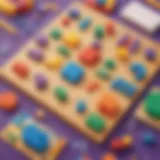Engaging Learners in the Classroom: Activities for Success
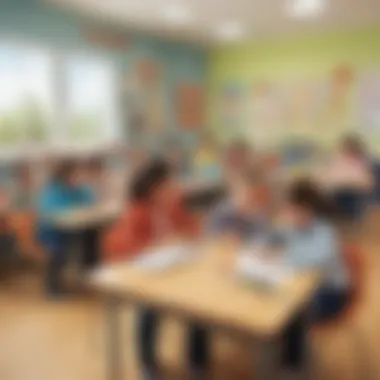

Intro
In today’s educational landscape, the role of engaging learners in the classroom is more crucial than ever. With elementary school children often having shorter attention spans, it is essential to employ effective activities that facilitate learning. This article provides a comprehensive overview of different activities that can stimulate young minds and enhance their understanding of various subjects. By actively involving students in their education, teachers can help improve comprehension and retention.
Creative Activities
Creative activities are vital for fostering a dynamic classroom environment. These activities allow children to express their thoughts and ideas while learning.
Craft Ideas
Craft activities can be fun and beneficial. Simple ideas like making paper plate masks or colorful greeting cards can spark creativity. Children can learn about colors, shapes, and even history or science through crafting. For instance, creating a solar system model using craft supplies not only engages students but also teaches them about planets.
Step-by-Step Guides
To implement these creative projects successfully, teachers should provide clear, step-by-step guides. Here’s a basic outline:
- Gather Materials: List out all required items such as colored paper, scissors, glue, etc.
- Instructions: Provide easy-to-follow directions. For example, for paper plate masks, instruct students to first cut eye holes, then decorate with markers or feathers.
- Execution: Allow time for students to work on their crafts, enabling them to make choices about colors and designs.
- Show and Tell: Encourage students to present their creations to the class. This builds confidence and public speaking skills.
Educational Value
Engaging in crafts provides numerous educational benefits. It promotes fine motor skills development and nurtures creativity. Furthermore, students can learn to collaborate and communicate as they work together on group projects. These experiences can have lasting effects on their academic journey, especially in enhancing critical thinking skills.
Fun Quizzes
Quizzes are another effective way to engage students. They serve not only as a medium of assessment, but also enhance learning through interaction.
Quiz Topics
On platforms like ElemFun, various topics are covered ranging from math and science to literature and art. Quizzes can be tailored to align with what the students are currently learning in class.
Question Types
Using a variety of question types keeps quizzes interesting. This may include multiple-choice questions, true or false queries, and short answer sections. Each format can challenge students differently and cater to diverse learning styles, thereby maintaining engagement throughout.
Knowledge Reinforcement
Quizzes reinforce knowledge by encouraging students to recall and apply what they have learned. This retrieval practice solidifies understanding and helps with retention. Moreover, instant feedback from quizzes guides students in identifying areas that need improvement.
Fact-Based Articles
Fact-based articles are an excellent resource for expanding knowledge. They present information in a structured and accessible manner, catering to curious young minds.
Topics
These articles can cover an array of topics, such as wildlife, space exploration, historical events, or even famous inventors. The breadth of choices allows teachers to select articles that align with their curriculum.
Engaging Content
To ensure engagement, articles should be written in clear, straightforward language, making them easy to understand. Each article can include fun facts or engaging illustrations to draw in young readers.
Preamble to Learners' Activities
The engagement of young minds in classroom settings is fundamental for their educational development. This introduction outlines the significance of learners' activities and frames the discussion that follows. By implementing diverse activities, educators can cater to various learning preferences and needs. This ensures that students not only grasp concepts but also retain them effectively.
One of the most pressing challenges in education is maintaining student interest. Traditional teaching methods often fall short, leading to disengagement. Therefore, emphasizing learners' activities shapes a more interactive environment. It creates opportunities for creativity, collaboration, and critical thinking that are essential in today's fast-paced world.
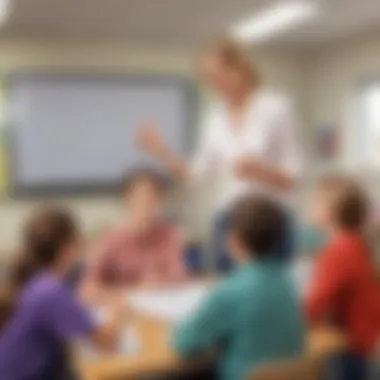

From group projects to hands-on learning, these activities promote a sense of community in the classroom. Young learners benefit from feeling connected to their peers, enhancing social skills while learning academic content. Furthermore, utilizing a variety of teaching methods recognizes the unique abilities within any given classroom. This awareness helps in reaching students who might otherwise struggle.
In essence, engaging young minds through carefully planned activities not only supports academic achievement but also fosters emotional and social intelligence. Thus, educators are encouraged to explore innovative strategies that make learning a more dynamic experience.
Defining Learners' Activities
Learners' activities encompass any instructional tasks that are designed to actively involve students in the learning process. These activities can vary widely, from individual assignments to collaborative group work. In essence, they include anything that combines education with engagement. Conversely, passive learning, where students merely listen and absorb information, usually leads to limited retention.
Some observable forms of learners' activities include:
- Hands-on experiments that allow students to apply concepts in real-world scenarios.
- Role-playing exercises that help in understanding perspectives and decision making.
- Interactive storytelling that promotes creativity and comprehension of literature.
The scope of learners' activities is broad and adaptable, aiming to meet the curriculum's requirements while also catering to the needs of students. This flexibility is crucial for promoting a responsive learning environment where students feel empowered to contribute.
Importance of Active Learning
Active learning is more than a teaching style; it is a necessity in cultivating a meaningful educational experience. Research shows that engaging students actively results in superior comprehension and retention compared to traditional methods. Through active learning, students become participants rather than mere observers of their educational journey.
Some of the key advantages include:
- Enhanced Understanding: When students engage directly with content, they can analyze, evaluate, and create knowledge rather than only memorizing facts.
- Improved Retention Rates: Activities that require collaboration and application often result in longer lasting memory of the material.
- Developing Critical Skills: Engaging in various types of activities fosters skills such as problem-solving, communication, and teamwork.
Types of Classroom Activities
Engaging young minds in the classroom requires thoughtful consideration of the activities used. Types of classroom activities significantly affect student engagement, comprehension, and retention of knowledge. Various activities cater to different learning styles and preferences. When educators implement diverse activities, they foster an inclusive environment where all students can thrive. Ultimately, selecting the right types of activities can transform a mundane lesson into a compelling learning experience, enhancing overall involvement and interest in the subject matter.
Group Projects
Group projects allow students to collaborate and share ideas. This approach not only builds social skills but also encourages critical thinking. In a group setting, children learn to delegate tasks, resolve conflicts, and support each other's learning. Importantly, group projects can be designed around specific objectives. For instance, students may work together on a science experiment or a presentation on a historical figure. By engaging in teamwork, they develop a sense of responsibility and accountability.
Hands-On Learning
Hands-on learning connects theory to practice. Through physical engagement, children can see concepts in action. For example, using manipulatives in math helps students visualize problems and solutions. Science experiments also provide tangible experiences that solidify understanding. This learning approach promotes curiosity and problem-solving skills. Furthermore, hands-on activities cater to kinesthetic learners, making learning accessible to various students.
Role-Playing Exercises
Role-playing exercises offer a unique opportunity for students to explore different perspectives. By acting out scenarios, kids can practice empathy and communication. This method is particularly effective in subjects like history or literature. For instance, students can reenact a historical event or take on the roles of characters in a story. Such activities encourage creativity and deeper comprehension of the material. Moreover, role-playing fosters confidence as students express themselves in front of their peers.
Interactive Storytelling
Interactive storytelling captivates young learners’ attention and imagination. This technique combines narrative with listener interaction. Educators can prompt students to contribute ideas or make decisions that affect the story's direction. Such engagement enhances listening skills and inspires creative thinking. Additionally, interactive storytelling can be aligned with curriculum objectives, making it a versatile tool in various subject areas.
Educational Games
Educational games blend learning with fun. They motivate students by providing a competitive element to the classroom. Games can be used to reinforce concepts in an engaging way. For example, trivia games can review facts from a unit while spelling games can improve language skills. By incorporating educational games into lessons, teachers create a dynamic environment. Students are more likely to retain information when they enjoy the learning process.
The Teacher's Role in Classroom Activities
Teachers play a crucial role in shaping the learning environment for students. They become facilitators of knowledge and inspire young learners to engage actively with content. The engagement of students is directly correlated to the type of classroom activities and the teacher's ability to implement them effectively. Understanding this role allows educators to create a more dynamic and fulfilling educational experience.
Facilitating Learning
Facilitating learning means guiding students through their educational journey. It involves more than just delivering information. Teachers need to create a supportive atmosphere where students feel comfortable exploring new ideas. This can be achieved through open-ended questions that stimulate critical thinking. Additionally, teachers should encourage collaboration among students to deepen understanding. Facilitation involves recognizing the learning pace of each student and adjusting strategies accordingly. Sometimes, it is necessary to offer additional resources or time to grasp certain concepts.
Designing Effective Activities
Designing effective activities requires a thoughtful approach to students’ needs. Activities should align with curriculum goals but also engage students personally. For instance, if the topic is environmental science, designing a project on local ecosystems can be engaging. This makes learning more relevant and stimulating. Furthermore, incorporating a variety of techniques—like visual aids, hands-on tasks, and technology—can cater to different learning styles. This way every student gets the chance to connect with the content meaningfully.
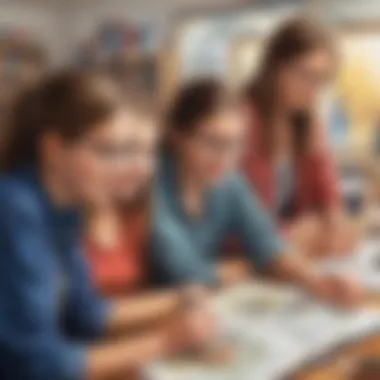

Assessing Student Participation
Assessment of student participation is key to understanding how well activities resonate with learners. It is not just about attendance; it involves observing how engaged students are during activities. Teachers can use various methods to gauge participation. These can include informal quizzes, group discussions, or individual reflections. Feedback forms can also be useful for students to voice their feelings about the activities. The aim is to identify what works and what does not.
Assessing engagement not only helps in refining activities but also highlights the learners’ interests and areas for improvement.
Implementing the insights gained from assessment can drive improvements. Teachers must adapt and evolve their strategies to maintain high levels of engagement.
In summary, teachers are essential for creating an engaging learning environment. Their ability to facilitate learning, design meaningful activities, and assess participation determines the effectiveness of learners' classroom experiences. By focusing on these elements, educators can enhance comprehension and retention among students.
Adapting Activities to Learning Styles
Adapting activities to learning styles is a fundamental aspect in creating an effective classroom. Recognition of students' varied ways of learning helps educators choose methods that resonate well with each child. This approach not only enhances engagement but also promotes a deeper comprehension of the material. Understanding and responding to the different learning styles in the classroom fosters a sense of inclusivity and acceptance.
The significance of adapting activities can be illustrated in multiple ways. First, it allows teachers to address the unique preferences of each learner. Some children may grasp concepts quickly through visuals, while others might excel with hands-on tasks. Utilizing multiple formats of instruction helps ensure all students can participate meaningfully.
Educators also benefit from adapting activities. When students are engaged and participating fully, classroom management becomes easier. A lively, interactive environment reduces behavior issues and creates a more conducive learning atmosphere.
Research indicates that when lessons align with students' preferred learning styles, academic performance improves significantly.
Understanding Different Learning Styles
Learning styles can broadly categorize how individuals assimilate and process information. Many frameworks exist to describe these preferences, but one common approach identifies three primary types: visual, auditory, and kinesthetic learners.
- Visual Learners: These students learn best with visual aids. Charts, diagrams, and pictures help them remember information effectively. For example, using colorful visuals in a presentation can markedly enhance their understanding.
- Auditory Learners: Students who fall into this category benefit from listening. Lectures, discussions, and audio recordings are particularly useful for them. Engaging them through storytelling or group discussions can create a strong learning bond.
- Kinesthetic Learners: These learners thrive on movement and hands-on experiences. Activities such as role-playing, crafting, or other physical tasks allow them to explore concepts actively. Incorporating these activities lead to more success in understanding.
By identifying these preferences, teachers can implement diverse strategies that allow each child to shine. For instance, a science lesson could include a visual diorama, a group discussion about the concepts, and a lab experiment to cater to all types of learners.
Personalizing Learning Experiences
Personalizing learning experiences is an essential extension of adapting activities to learning styles. It allows educators to tailor the lessons further to meet each student's needs. Understanding individual interests and strengths can spark motivation and enhance learning.
To personalize learning, teachers can:
- Incorporate Student Interests: Design activities that relate to students' hobbies or curiosities. If a student loves animals, integrating biology lessons with animal-focused projects can increase engagement.
- Use Varied Assessment Methods: Rather than a one-size-fits-all approach, offering different ways to demonstrate knowledge, such as presentations, posters, or written assignments, accommodates diverse preferences.
- Implement Flexible Grouping: Allow students to work together in various configurations. This variation encourages collaboration and exposes learners to others’ strengths and perspectives.
Ultimately, establishing a personalized approach to learning generates an atmosphere of respect and value for each student. Children feel more appreciated and understood, positively influencing their academic journey.
Challenges in Implementing Learners' Activities
Implementing engaging learners' activities in the classroom is not without its challenges. Understanding these obstacles is vital for educators who strive to create an enriched learning environment for young minds. This section explores key challenges such as time constraints, classroom management issues, and resource limitations. By addressing these challenges, teachers can develop strategies that improve the effectiveness of classroom activities.
Time Constraints
Time is a significant factor that educators must navigate daily. Teachers often face rigid schedules, where every minute is accounted for. This can make it difficult to incorporate diverse activities into lessons. In some cases, teachers may feel compelled to prioritize content delivery over interactive experiences. However, delivering materials in an engaging manner can actually save time in the long run. When students are engaged, they grasp concepts quicker and retain information better, which can decrease the need for extensive review sessions later.
To maximize time, educators can:
- Integrate activities into existing curricula. For instance, transforming a reading assignment into a group discussion can fulfill both reading goals and collaborative skills.
- Plan efficiently. Setting clear objectives for each activity helps streamline the process.
- Utilize technology. Digital tools can save time by providing instant feedback and engaging formats.
Classroom Management Issues
Classroom management can be another hurdle when implementing activities. Active learning methods often require different dynamics than traditional teaching styles. If not managed well, activities can devolve into chaos, leading to distraction and confusion. A teacher's ability to maintain structure directly influences the success of learners' activities.
To foster effective management, teachers can:
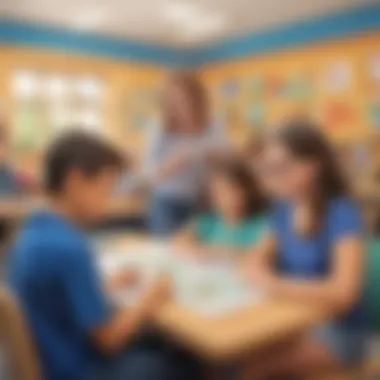

- Set clear expectations. Before beginning an activity, outlining rules and desired outcomes helps guide student behavior.
- Use small groups. Managing smaller teams can minimize disruptions and allow for more personalized guidance.
- Implement routines. Familiarity with processes can keep students focused and engaged.
Resource Limitations
The availability of resources is often a limiting factor. Some educators may not have access to materials, technology, or space needed for certain activities. This limitation can stifle creativity and hinder the ability to provide students with hands-on experiences. However, instructors can be resourceful, thinking outside the box to make the most of existing materials.
Ideas to overcome resource shortages include:
- Repurposing materials. Common items like everyday household objects can support numerous activities.
- Collaborating with others. Joining forces with other teachers or local organizations may provide additional resources or expertise.
- Maximizing free tools. Online platforms can offer free resources that can enrich activities without additional costs.
"Engaging young minds requires not just creativity but also strategic thinking to address barriers inherent in educational environments."
By recognizing and addressing these challenges, educators can position themselves to create more engaging and effective learners' activities, ultimately fostering a more productive learning environment.
Evaluating the Effectiveness of Activities
Evaluating the effectiveness of activities is essential for teachers seeking to improve their instructional methods and enhance student learning. Effective evaluation helps determine if the activities meet learning objectives and fosters a productive classroom environment. By understanding what works and what doesn't, educators can refine their approaches. This process ties directly into the overall goal of increasing student engagement and retention.
The evaluation of activities encompasses various elements. It is crucial for teachers to identify metrics that will accurately reflect the success of their methods. These might include changes in participation levels, behavior during activities, and students' comprehension of the material. Analyzing these aspects not only benefits students but also supports teachers in crafting more effective lessons in the future.
Benefits of evaluating activities include the ability to:
- Identify successful strategies that encourage student participation.
- Adjust teaching methods based on real-time feedback from students.
- Ensure alignment with curriculum standards and learning outcomes.
Overall, evaluating the effectiveness of classroom activities contributes significantly to professional development and ultimately leads to a more enriching learning experience for all involved.
Gathering Student Feedback
Collecting student feedback is fundamental to evaluating classroom activities. Student insights provide invaluable data on how well activities resonate or miss the mark with diverse learners. This feedback can come in numerous forms, including surveys, informal discussions, or through exit tickets at the end of a lesson. The goal is to gather honest reflections on what aspects of the activities students found engaging or challenging.
Benefits of gathering student feedback include:
- Understanding Student Needs: Direct comments give teachers a clearer picture of individual differences in learning preferences and challenges.
- Improving Future Planning: Feedback can shine a light on which activities might require adjustments or replacements altogether.
- Boosting Student Ownership: When students see their input valued, they are more likely to engage actively in their learning process, feeling a sense of ownership over their education.
Using tools like Google Forms or simple paper surveys can streamline the feedback gathering process. Additionally, fostering an open classroom environment where students feel comfortable sharing their thoughts will lead to more candid responses.
Assessing Learning Outcomes
Assessing learning outcomes is crucial in determining whether educational activities achieve the desired results. This assessment can be accomplished through various methods, such as quizzes, formal assessments, or observational tracking during activities. Each approach offers different insights into learner comprehension and retention.
When assessing learning outcomes, key considerations include:
- Alignment with Objectives: Ensure assessments reflect the learning goals established prior to the activities.
- Diverse Assessment Methods: Weigh results from different assessment types to get a well-rounded view of student understanding.
- Timeliness: Conduct assessments shortly after activities to capture immediate learning retention while content is still fresh in students' minds.
Ultimately, effective assessment allows educators to determine their impact and helps identify areas needing further attention. Engaging with students about their outcomes promotes a growth mindset that enhances their learning journey.
End: Future Directions for Learners' Activities
Looking ahead, the sphere of learners' activities in classrooms is poised for significant evolution. This section delves into some noteworthy aspects of these future directions, emphasizing their relevance for educators, parents, and stakeholders invested in a child's cognitive development.
One key element of future directions focuses on emerging trends in education. These trends typically reflect responses to fast-changing societal needs and technological advancements. For instance, the integration of personalized learning experiences has gained momentum. In this context, educators are increasingly leveraging adaptive learning technologies that tailor educational content to the individual pace and style of each child. This approach not only enhances engagement but also fosters a deeper level of understanding and retention of material. The emphasis remains on active participation, as children are encouraged to take ownership of their learning through customized pathways.
Emerging Trends in Education
Emerging trends indicate a shift towards collaborative learning environments. Classroom activities are trending toward enhancing teamwork and communication skills. Students are often encouraged to work in groups, where diverse perspectives enrich their insights. Cooperative projects, peer teaching, and cross-disciplinary activities have become commonplace. These methods affirm the importance of social interaction in learning, which significantly benefits young learners.
Additionally, project-based learning is now becoming a focal point of elementary education. This approach engages students by integrating real-world issues into the learning process. It encourages critical thinking by challenging students to solve problems and develop original solutions. Not only does this foster a sense of accomplishment, but it also prepares students for future societal contributions.
The Role of Technology in Learning
Technology plays a pivotal role in shaping the future of learners' activities. With the advance of educational technologies, interactive platforms such as Google Classroom and Kahoot! have started to redefine how students engage with content. These tools make learning more dynamic and appealing by incorporating gamification. By transforming lessons into games, motivation and enjoyment are boosted.
Moreover, the role of augmented reality in education is gaining traction. Tools like Merge Cube allow students to visualize complex concepts in three dimensions. This not only captivates students’ attention but also aids comprehension of intricate topics. The exposure to technology also prepares students for a future where digital literacy is crucial.
